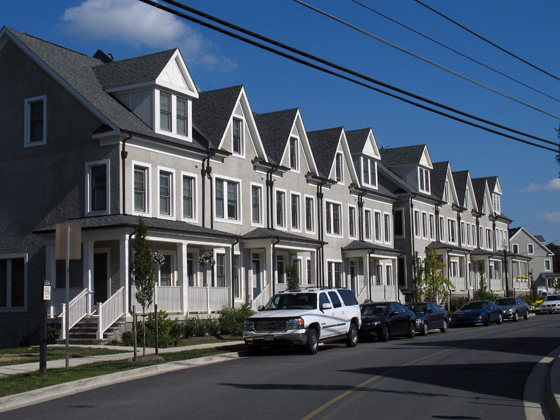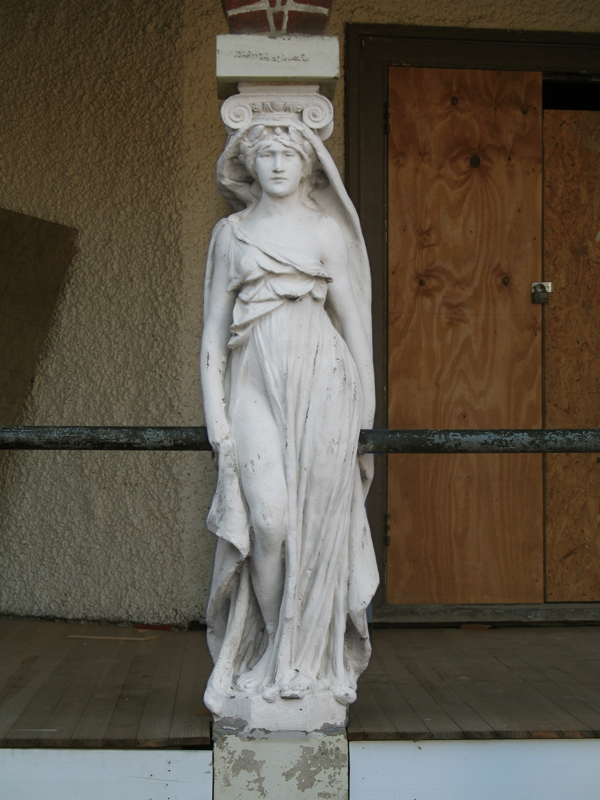The ugly and the ordinary before “The Ugly and The Ordinary.”
Tag: ugliness
The Metronomicon

A Russian artist and ad man named Alexei Andreev has been publishing some distinctly surreal photography recently regarding the Moscow Sankt-Peterburg Metro. Mostly, it hints at the perpetual creepiness of a dark subway and the complex relationship one always has with it. As much as it’s preternatural eeriness, it also reflects daily life a lot more than most architectural photography of the subway. The whole collection deserves a look, but not before a late night Metro ride.
Forest Glen Seminary: One Thing Leads to Another
Against rich complexity of the old Seminary, the houses designed by EYA are then a real letdown. They carry the superficial veneer of “context” that is endemic to New Urbanist planning and its most visible error. To be clear, they are not abominations, but they are dull and only stylistically similar to the outré conglomeration across the street. The application of traditional elements here fulfills a requirement that new buildings respect the architecture of the historic landmark. Okay, sure, sounds good, but the legislation is fairly scant in the details of execution. The easy option, a cynical abdication of artistic responsibility, is to copy the notions of form in hazy facsimile and slap it on off-the-shelf buildings. Even where the designs are competent, the lack of sensitivity results in tepid mediocrity.
Continue reading ➞ Forest Glen Seminary: One Thing Leads to Another
Forest Glen Seminary: Into the Woods
Hidden among a leafy scattering of houses and trees, Forest Glen Seminary is a jumble of vernacular buildings unlike any of the temples of boxes that define Washington. Its buildings, both magnificent and ludicrous amount to a dignified campiness that defies expectations to be one of the most profoundly interesting places encircled by the Beltway. Once constituting a women’s college when that meant a two-year Mrs. degree, the buildings are once again becoming domestic space, the more private areas cut into condos and the core of the complex, rental units. Scattered around the area, turn-of-the-century houses are being renovated and new housing by the urbanist developer EYA has just been finished. Through the site’s history, radical changes have shaped its form, but none so radical as the current shift in context.
April 9th, 1865
 Let us remember the handing down of of the deadliest precedent in constitutional law on this, its 144th anniversary.
Let us remember the handing down of of the deadliest precedent in constitutional law on this, its 144th anniversary.
Why Design Matters for the Stimulus: Architects

Unless they are receiving unemployment benefits, the stimulus package is not something that will benefit most architects in any direct way. Mostly consisting of spending for non-physical programs, the ≈$94,000,000,000 that is there for infrastructure and construction is not going to any public projects that conventionally get the high-end architecture treatment. Yet if governments and agencies receive grants for utilities or other community assets and approach these structures with an eye to aesthetics, there is the potential for incredible additions to the fabric of our of towns and cities.
If the average architect wants to get design into these buildings, they’re going to have to look to practice architecture differently than they currently do. Firstly, they need to embrace building information modeling. Secondly, they need to emphasize designing details rather than looking at sophisticated conceptual schemes as justifications for form. Thirdly, architects need to look for different opportunities than what they have conventionally seen as prestige architecture projects.
Continue reading ➞ Why Design Matters for the Stimulus: Architects
Why Design Matters for the Stimulus: The Government
In choosing to spend so much money to build new infrastructure, Congress and the President have committed to constructing utilities and transportation for the next fifty years. Consequently, all of these structures and systems must reflect this long-term goal, not only in the quality of construction but also in the quality of design. As they allocate the federal funding, governments and agencies should consider the very real need for public projects to employ an architecture of civic responsibility. Architects, in turn, should be ready to adapt their practices to meet the need for basic public design, a major shift many are eager to try.
First off, it’s worth explaining what the stimulus bill offers architects and agencies? There are two major categories: firstly, sustainable or “green” renovations and expansions of housing, schools, and government offices, and secondly, the money granted to local utilities chance to be creative with unconventional programs and types with a thin budget. The former type of project is not too different from what they’d be doing most days, although those firms would benefit greatly from improving technological capabilities, such as employing building information modeling, which reduces cost and improves quality by reducing errors, simplifying design, and allowing for sophisticated environmental testing. The government should encourage the use of these programs, setting a standard for 21st-century architecture and construction.

In the second category, there are many types of buildings that have been neglected aesthetically or financially that are now receiving large grants as part of the stimulus. Transportation, power plants and electrical systems, water treatment facilities, housing projects, and port facilities will all be receiving funding for improvements. The government owes it to the people who live by, pass through, or otherwise see the underside of public infrastructure to improve quality. More attractive overpasses, wind farms, and customs houses will make a small but important improvement of the built environment, definitely impacting the daily lives of Americans.
Similarly, funding for transit organizations can go to better bus shelters or bike stands. As the recent competition in New York showed, small firms are ready to make simple but interesting designs for little bits and pieces on the street. Both proponents and opponents of spending are fixated on monumental projects, things that will last. However, wide projects of small improvements might make just as much of an economic and physical improvement. Planting thousands of trees would pay off far more than another highway resurfacing, especially as part of a greater streetscape improvement plan. Moreover, agencies should set aside a small portion of their funds to ensure that a little art and a little design make it into every project, improving the quality and distinctiveness of each and every location. Many of these facilites are in people’s backyards; planners need to respect the neighbors.
A notable exception to the recent pattern of charmless public architecture is the Newtown Creek Wastewater Treatment Plant, in Queens. Designed by the ever-pragmatic and flexible Polshek Partnership Architects of Newseum fame, the multi-million dollar project has met with universal praise and become an icon of the area, while still efficiently treating blackwater sewage. Polshek designed it with a modern industrial look, simplifying and beautifying the fascinating shapes of anaerobic digesters and aeration buildings. Additionally, the building is designed for tours and educational visits, while a 1% allotment for art has allowed for bold lighting that stands in contrast to the dull orange glow of the city.
Through all the praise for both the Newtown Creek plant, critics and officials have emphasized how different they look from conventional buildings and how much more attractively these massive plants interact with the rest of the neighborhood. People are surprised that the buildings aren’t ugly, as though this is an innovation that took a genius. However, architects have historically approached such facilities as civic assets, building them out in a monumental fashion. Likewise, the New Deal introduced art and architecture to almost every project it executed, from libraries to TVA dams. These buildings reflected the cultures and programs of their builders. It would reflect poorly on our time if we settle for bare function and apathy.
Government’s role in improving and stewarding common places means that it must provide and demand attractive, functional facilities for its people. For this reason, renewing America means not only fixing it up at basic levels, but also making it more beautiful at the same time. Architects are ready and eager to improve the country, but they will have to adapt to new conditions. Indeed, they may be better for it if they grow creatively in response to limitations and employ technology in making practice faster and more transparent. But they have to get the work. If agencies set aside only a small portion of funds for architecture, lay out the goals, pick like-minded architects, and insist on good results, the resulting cultural effusion would boost the resolve of Americans and leave a long-lasting improvements in the most desperately needed places.
In Part Two, some thoughts on how architects should approach Stimulus design.


